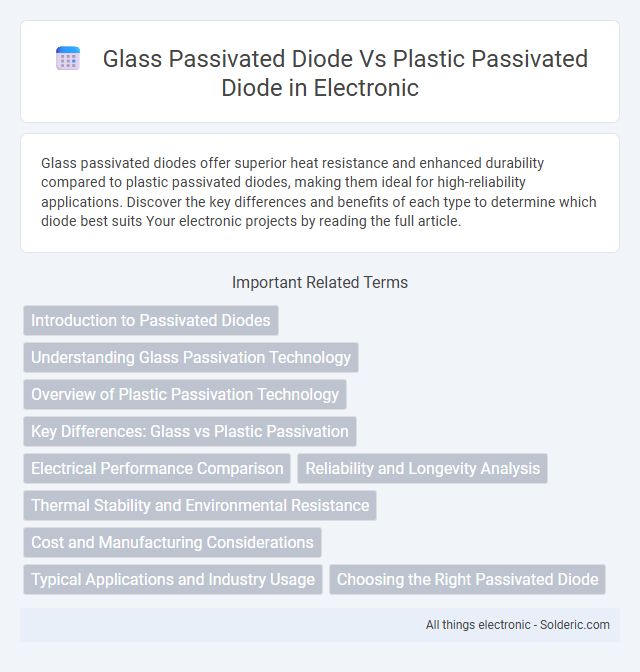Glass passivated diodes offer superior heat resistance and enhanced durability compared to plastic passivated diodes, making them ideal for high-reliability applications. Discover the key differences and benefits of each type to determine which diode best suits Your electronic projects by reading the full article.
Comparison Table
| Feature | Glass Passivated Diode | Plastic Passivated Diode |
|---|---|---|
| Passivation Material | Glass | Plastic |
| Reliability | High, excellent long-term stability | Moderate, less resistant to harsh environments |
| Thermal Resistance | Higher thermal resistance | Lower thermal resistance |
| Leakage Current | Lower leakage current | Higher leakage current |
| Cost | Higher manufacturing cost | Lower manufacturing cost |
| Application | High-reliability circuits, industrial and automotive | Consumer electronics, general-purpose circuits |
| Mechanical Strength | Good mechanical strength | Moderate mechanical strength |
Introduction to Passivated Diodes
Passivated diodes feature a protective layer that enhances reliability and electrical performance by minimizing surface leakage currents and protecting the p-n junction. Glass passivated diodes utilize a thin glass layer for superior hermetic sealing, resulting in improved thermal stability and long-term durability compared to plastic passivated diodes, which employ epoxy molding compounds offering cost-effectiveness with moderate environmental resistance. The choice between glass and plastic passivation impacts diode parameters such as leakage current, breakdown voltage, and junction stability under high-temperature conditions.
Understanding Glass Passivation Technology
Glass passivation technology involves coating the diode's semiconductor surface with a thin layer of glass, enhancing its reliability by protecting against environmental contamination and electrical stress. This technology improves the diode's thermal stability, reduces leakage current, and extends its operational lifespan compared to plastic passivated diodes. Glass passivated diodes are preferred in high-reliability and high-temperature applications due to their superior electrical characteristics and robust passivation layer.
Overview of Plastic Passivation Technology
Plastic passivation technology utilizes polymer-based coatings to protect diode junctions from environmental contaminants and mechanical damage, offering cost-effective durability and ease of manufacturing. This method provides reliable surface insulation and moisture resistance, improving the diode's electrical performance and prolonging operational lifespan compared to traditional glass passivation. Plastic passivated diodes are commonly favored in high-volume electronic applications due to their scalability and enhanced robustness under varying temperature and humidity conditions.
Key Differences: Glass vs Plastic Passivation
Glass passivated diodes feature a glass layer that provides superior hermetic sealing, resulting in higher reliability, better high-temperature stability, and enhanced resistance to moisture and contaminants compared to plastic passivated diodes. Plastic passivated diodes use an organic polymer coating, offering cost-effectiveness and lightweight construction but with lower thermal endurance and slightly reduced long-term stability. Your choice depends on the operating environment, where glass passivation suits high-stress or high-frequency applications, while plastic passivation fits general-purpose, low-stress uses.
Electrical Performance Comparison
Glass passivated diodes offer superior electrical performance compared to plastic passivated diodes due to lower leakage currents and higher avalanche energy ratings. Glass passivation provides enhanced reliability in high-temperature and high-voltage applications, resulting in better stability and reduced reverse leakage. Your choice of diode should consider glass passivated types for demanding environments requiring robust electrical characteristics and improved thermal endurance.
Reliability and Longevity Analysis
Glass passivated diodes exhibit superior reliability and longevity compared to plastic passivated diodes due to their enhanced protection against moisture and contaminants, which significantly reduces leakage currents and thermal breakdown risks. The glass passivation layer ensures stable junction characteristics under high-temperature and high-stress conditions, making these diodes ideal for applications requiring long-term durability and consistent performance. Your choice of glass passivated diodes can lead to improved circuit lifespan and reduced maintenance in critical electronic systems.
Thermal Stability and Environmental Resistance
Glass passivated diodes exhibit superior thermal stability due to their hermetic sealing, allowing them to withstand higher temperatures and maintain performance under thermal cycling better than plastic passivated diodes. In terms of environmental resistance, glass passivated diodes provide enhanced protection against moisture, contaminants, and corrosion, making them ideal for harsh and high-reliability applications compared to the plastic passivated counterparts, which are more susceptible to environmental degradation. This makes glass passivated diodes preferable in automotive, industrial, and aerospace environments where long-term durability and thermal reliability are critical.
Cost and Manufacturing Considerations
Glass passivated diodes typically cost more due to the intricate manufacturing process that involves sealing the diode with a glass layer for enhanced reliability and thermal stability. Plastic passivated diodes are more cost-effective, benefiting from simpler, high-volume manufacturing techniques with plastic encapsulation that reduces material and production expenses. Your choice between the two will depend on balancing budget constraints with performance requirements, as glass passivation demands greater precision and cost but offers superior durability.
Typical Applications and Industry Usage
Glass passivated diodes are extensively used in high-reliability applications such as aerospace, military, and telecommunications due to their superior thermal stability and low leakage current. Plastic passivated diodes are preferred in consumer electronics, automotive circuits, and general-purpose rectification where cost-effectiveness and moderate performance are required. Industries demanding robust performance under harsh conditions typically favor glass passivated diodes, while mass-produced devices lean towards plastic passivated counterparts.
Choosing the Right Passivated Diode
Glass passivated diodes offer superior thermal stability and lower leakage currents compared to plastic passivated diodes, making them ideal for high-reliability applications and harsh environments. Plastic passivated diodes provide cost-effective solutions with adequate performance in general-purpose circuits where extreme conditions are absent. Selecting the right passivated diode depends on balancing operational temperature range, environmental exposure, and application-specific electrical requirements.
Glass passivated diode vs plastic passivated diode Infographic

 solderic.com
solderic.com